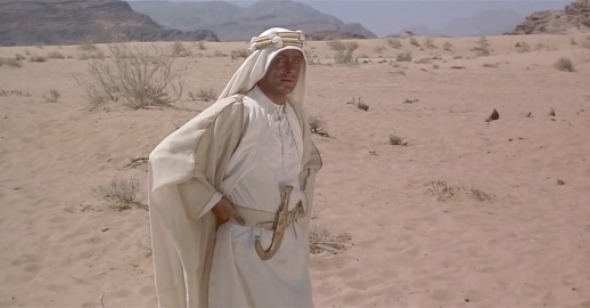White Material
Kiva Reardon on Lawrence of Arabia
When we think of iconic uses of color in cinema, it’s usually the vibrant colors we first recall: Dorothy’s ruby slippers, Melanie Daniels’s green dress in The Birds, the yellow rain jackets worn by the three stars of Singin’ in the Rain. Choosing to focus on white—not even a color, but a lack of color—might seem dull, then. White, however, is integral to film not merely at the level of symbolism, but in the way it functions within the film apparatus itself. Unlike the human eye, which sees black when it is closed, the “empty” space of film is white—the blinding white that burns on the screen and punctures the retina before a reel is loaded or when it unspools. So while endings are marked with a fade or cut to black, mimicking the experience of closing the human eye, when there is nothing to see on film we encounter a whiteout.
The common assumptions of white are purity, virginity, and new beginnings, but the white robes in David Lean’s Lawrence of Arabia employ this lack of color it for its distinct visual sensation. A blackout may be disorienting, but a whiteout is painful and blinding. In this way the robes worn by Lawrence (Peter O’Toole) become a point of puncture in the film—a near rupture in the stock that acts as a defined space or hole—highlighting not merely the character’s centrality to the narrative but also his indefinable essence. For when we register white, the three cone cells in our eyes, responsible for our color vision, are stimulated in equal amounts. They are overpowered; in a manner, to see white is to be blinded (white light is, of course, also generated by the sun). Unlike black, which absorbs all colors, white reflects everything back to the eye, so in seeing everything we see nothing.
The film’s understanding of T.E. Lawrence (or lack thereof) is encapsulated in its use of white. That we know Lawrence's fate at the outset of the film renders his figure on screen akin to that of a ghost. The white of his robes reinforces this, as his silhouette is rendered visible by the space it carves out around him—like a puncture, only the edges remain. Thus, in the way white reflects everything back to us, readings of Lawrence’s character find no fixed point. Unlike with a black hole (both the color and phenomena), we are not sucked into his space but must continually work around the borders of his image, which (paradoxically) give shape to his lack of presence.
The unique enigma of Lawrence is further heightened by the film’s muted color palette. Dominated by beige, khaki and low-key reds, the palette is balanced to the point of being banal, so everything is uncannily uniform. Think of the camels walking along a dune in Wadi Rum. From afar they are several black dots with no distinction—that is, until Lawrence’s white robes are introduced. A ceremonial present from Sherif Ali (Omar Sharif) given before the men cross the treacherous Nefud desert, this ethnic garb marks an important character shift—from Lawrence as the British officer and outsider to (his perceived) inclusion amongst the Arab leaders. It also marks a change in the film’s color landscape. Until this point, Lawrence has visually blended with the palette and been dwarfed like the others on screen in the film’s many sweeping shots. Now, however, in his blinding white robes, Lawrence—whether atop a train or on the warpath to Damascus—pierces the screen.
This shift to white as the focal point is further compounded by the film’s overture and intermission. Lawrence of Arabia begins with a prolonged period of black screen filled with music and is divided by a similar section in the middle. Though this convention of fifties and sixties epic filmmaking could now be dismissed as extraneous, their inclusion (reportedly at Lean’s insistence) begs they be taken as part of the film’s whole, thus their purposeful darkness cannot be dismissed. For these deliberate black shots set the tone for the film. And in sitting through these periods of black, we become attuned to the pain and power of white when it appears. As though we have emerged from a cave, our eyes are already made sensitive to light when the narrative begins in England, and Lawrence crashes to his death in a motorcycle accident.
Lawrence’s robes, of course, do not provide the only white in the film. There are the Empire’s army headquarters in Cairo, the map upon which Lawrence draws, the sun-bleached desert shrubbery, the sand, and of course, the sun itself. The robes, however, gradually replace them all as the dominant elements in the frame. Here the crucial moment arrives when he rescues his young servant Gasim, who falls from his camel in the night while crossing the Nefud. Against Sherif Ali’s wishes, Lawrence retraces his steps to find Gasim, carrying him triumphantly back to the group. While at the level of narrative this plays a role in Lawrence’s further acceptance by Sherif Ali, visually it recalibrates the center of the film. The sequence begins with a shot of the sun rising (warm reds and pinks), and following this there are five shots of the sun that are cross-cut with shots of Lawrence and Gasim. In each, the sun increases in size until its white light overpowers the screen. Recalling the opening contrast in the shift from the black overture to Lawrence on his motorbike, the white at this point becomes painful—literally to the audience’s eyes and for the agonizing death it presages for the characters. In surviving a whiteout, Lawrence becomes the film’s fixed point—its gravitational pull, even. He draws everything in and towards him. He is an absent present.
